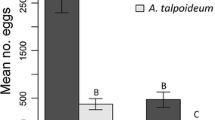Abstract
Mortality of eggs during incubation was estimated for three ocypodid crabs,Scopimera globosa, Ilyoplax pusillus andMacrophthalmus japonicus, and the influence of incubation sites was discussed. These crabs all lived in isolated burrows and fed on sediments during day time low tide.S. globosa andI. pusillus inhabited the upper intertidal sandflats, whereasM. japonicus inhabited the lower intertidal mudflats. Females of bothS. globosa andI. pusillus remained in their plugged burrows without feeding throughout incubation and the mortality of eggs was low despite large broods relative to body size. On the other hand, females ofM. japonicus fed actively on surface mud during incubation and the mortality of eggs was high despiite small broods relative to body size. InS. globosa andI. pusillus, the ovaries of ovigerous females were small until egg-hatching, whereas inM. japonicus, the ovaries grew rapidly during incubation and females were able to produce consecutive broods. I conclude that incubation of eggs in burrows may be advantageous in species which inhabit the upper interidal sandflats, even though the crabs cannot forage during incubation, since otherwise their eggs would be exposed to strong heat stress and desication during the summer. Furthermore, such species may produce few large broods because of less frequent interruption of feeding than that associated with production of many small broods.
Similar content being viewed by others
References
Christy, J. H. (1982) Burrow structure and use in the sand fiddler crab,uca pugilator (Bosc). Anim. Behav.30: 687–694.
— (1984) Ecology and evolution of mating systems of fiddler crabs (genusUca). Biol. Rev.59: 483–509.
Haley, S. R. (1973) On the use of morphometric data as a guide to reproductive maturity in the ghost crab,Ocypode ceratophthalmus (Pallas) (Brachyura, Ocypodidac). Pacific Sci.27: 350–362.
Hazlett, B. A. (1983) Parental behavior in decapod crustacea. “Studies in adaptation. The behavior of higher Crustacea” (ed. Rebach, S. & Dunham, D. W.), 171–193. Wiley-Interscience, New York,
Henmi, Y. (1984) The description of wandering behavior and its occurrence varying in different tidal areas inMacrophthalmus japonicus (De Haan) (Crustacea: Ocypodidae). J. Exp. Mar. Biol. Ecol.84: 211–224.
— (1989) Life-history patterns in two forms ofMacrophthalmus japonicus (Crustacea: Brachyura). Mar. Biol.101: 53–60.
— &Kaneto, M. (1989) Reproductive ecology of three ocypodid crabs. I. The influence of activity difference on the reproductive traits. Ecol. Res4: 17–29.
Jones, M. B. (1977) Breedin and seasonal population changes ofPetrolishtes elengatus (Crustacea, Decapod, Anomura) at Kaikoura, New Zealand. J. Royal Society N. Z.7: 259–272.
— (1980) Reproductive ecology of the estuarine burrowing mud crabHelice crassa (Grapsidae). Estuarine and Coastal Marine Science2: 433–443.
Murai, M., Goshima, S. &Henmi, Y. (1987) Analysis of the mating system of the fiddler crab,Uca lactea. Anim. Behav.35: 1334–1342.
Omori, K., Mori, K. &Nishino, T. (1984) The variation of life history traits ofMacrophthalmus japonicus De Haan (Ocypodidae: Decapoda) according to environmental heterogeneity. I. The problems to be solved. Benthos Res.27: 28–37.
Ono, Y. (1965) On the ecological distribution of ocypodid crabs in the stuary. Mem. Fac. Sci., Kyushu Univ, Ser. E (Biol.)4: 1–60.
Piersma, T. (1986) Eastern curlewsNumenius madagascariensis feeding onMacrophthalmus and other ocypodid crabs in the Nakdong Estuary, South Korea. Emu86: 155–160.
Pillai, C. K. &Subramoniam, T. (1985) Yolk utilization as an adaptive startegy of terrestrialization in the freshwater crabParatelphysa hydrodromous (Herbst). Physiol., Zool.58: 445–457.
Salmon, M. (1984) The courtship, aggression and mating system of a “primitive” fiddler crab (Uca vocans: Ocypodidae). Trans. Zool., Soc. Lond.37: 1–50.
— (1987) On the reproductive behavior of the fiddler crabUca thayeri, with comparisons toU. pugilator andU. vocans: evidence for behavioral convergence. J. Crust. Biol.7: 25–44.
Wada, K. (1976) The distribution of three species of ocypodid crabs in the estuary of Waka River, mainly examined in relation to the granularity of substratum. Physiol. Ecol. Japan17: 321–326.
— (1978) Two forms ofMarcophthalmus japonicus De Haan (Crustacea: Brachyura). Publ. Seto Mar. Biol. Lab.24: 327–340.
Yamaguchi, T. (1971) Courtship behaviour of a fiddler crab,Uca lactea. Kumamoto J. Sci. Biol.10: 13–37.
Author information
Authors and Affiliations
About this article
Cite this article
Henmi, Y. Reproductive ecology of three ocypodid crabs II. Incubation sites and egg mortality. Ecol. Res. 4, 261–269 (1989). https://doi.org/10.1007/BF02348447
Accepted:
Issue Date:
DOI: https://doi.org/10.1007/BF02348447




